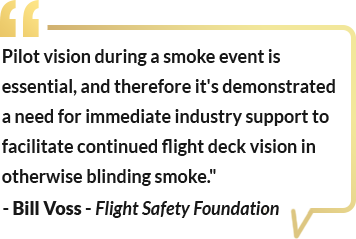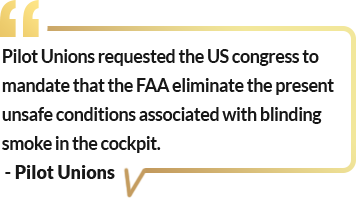


EVAS has been widely adopted among operators of Private Jets, with over 3000 EVAS units having been installed between Gulfstream, Bombardier, Dassault and Embraer aircraft.
The Emergency Vision Assurance System (EVAS) has been widely adopted by those who fly on private jets. EVAS is available for the majority of medium to long range aircraft types as either standard equipment or on the options lists.
After numerous incidences of smoke impeding pilots vision, and with catastrophic loss as a result, VisionSafe corporation came up with the solution. Bombardier, Dassault Falcon Jet, and Gulfstream Aerospace have designated EVAS as standard client option for their prestigious line of jet aircraft.

Well over 2000 ETOPS aircraft are EVAS equipped.

Certified for use on 10 OEMs and over 120 Aircraft Type.

EVAS is equipped on over 1000 Gulfstream Aircraft.
After thorough evaluation and review Gulfstream awarded VisionSafe as supplier of the year. Gulfstream has also designated EVAS as a standard equipment on the G650 and as standard client option for the rest of their prestigious line of aircraft.
“Oil from the APU (Auxiliary Power Unit) was leaking into the air conditioning hot-air ducts, which resulted in a great deal of smoke in the cockpit. The smoke began coming in through the air vents and filling the cabin and cockpit to the point where I couldn’t see anything, including the flight instruments. At nighttime with an overhead light turned on, it created a beam of light which did nothing more than illuminate the smoke in the cockpit. This is like turning your high beams on and driving in fog. You can’t see anything, except what’s close to you. We donned our smoke goggles which protected our eyes against the smoke, but we still were unable to see anything. I had to lean so far forward in an attempt to see the flight instruments that I was pushing on the yoke. I was leaning in such a very awkward position simply to see the flight instruments..”
“Another emergency I had was a burning air conditioning recirculation fan. It was burning up and shorting out, and the fumes were so noxious they were burning our eyes, and our throats. We needed to shut down all our electric equipment to try to figure out what was causing this, so we shut everything off, including our weather radar, which we were using to circumnavigate thunderstorms. That was a bit hair raising.”
“The cockpit filled with smoke, it wasn’t insidious, it happened all of a sudden, real quickly, and we didn’t know what caused that one, but we had the same issue--I couldn’t see my flight instruments. I had to put on my mask and goggles, and the oxygen mask hose caught on something. I couldn’t lean forward, and couldn’t figure out what it was caught on. I couldn’t see anything anyway, so here I am trying to get closer to my flight instruments, and I couldn’t. I couldn’t see the panel, so I’m feeling around the cockpit by hand where the auto pilot controls are, Until we get this smoke issue resolved, we can’t see anything in the cockpit or what to do.”




David Dalpiaz shares why EVAS is so important
An overview of the Emergency Vision Assurance System
